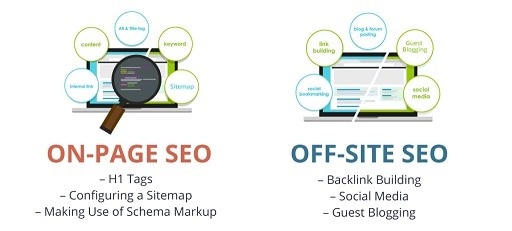Entering the realm of SEO can feel like diving into the depths of an ocean. For many content marketing professionals, who may lack technical expertise and prioritize the editorial quality of their content, SEO can seem like an obscure and intimidating landscape, full of hidden obstacles and complexity.
Even large companies can struggle with SEO, often avoiding it altogether, resulting in lower rankings on Google and a significant loss of traffic and potential customers, according to the Content Marketing Institute.
Despite its perceived complexity, SEO is not an insurmountable challenge. In this article, I will present some SEO techniques that can enhance the Google value of your content without compromising its editorial quality. But before diving into the techniques, it’s essential to understand the various types of SEO you may encounter.

Types of On-Page and Off-Page SEO
To effectively optimize your website for search engines, it’s important to consider three types of SEO: on-page, off-page, and technical. According to Neil Patel, technical SEO pertains to any SEO-related work that goes beyond the website’s content. On the other hand, on-page SEO encompasses all the actions you can take directly on your website and content, while off-page SEO pertains to everything external to your website.
While all types of SEO are crucial for overall optimization, a recommended step-by-step approach for improving your SEO would be to begin with on-page SEO, followed by technical SEO, and then focusing on off-page optimization.
If you’re interested in learning about my top SEO techniques that you can easily implement on your own, keep reading!
On-Page SEO
Write great quality content
Content is considered to be the king not just by marketers, but also by SEO experts. Search engines are continuously enhancing their algorithms, and they will not rank poorly written, plagiarized, or misleading content, as every detail, including spelling errors, counts. Therefore, it’s essential to ensure that your content quality is impeccable, unique, and engaging. The content should be published originally on your website and provide value to your readers.
Publish Consistently
The frequency of your blogging can have a significant impact on your rankings as fresh content is highly valued by Google, which constantly seeks new pages to index.
It’s important to ask yourself whether you keep your content up-to-date. However, it’s essential to note that quality, rather than quantity, is what matters most in the end.
Use proper URL Structures
Proper URL structures in SEO refer to the way URLs are constructed and optimized for search engines to understand and rank them better. The following are some key factors to consider for proper URL structures:
- Keep URLs simple and readable: Use simple, descriptive words that accurately reflect the content on the page, and avoid using long or irrelevant words.
- Use hyphens to separate words: Hyphens are recommended over underscores because they are more readable to both users and search engines.
- Keep URLs short: Shorter URLs tend to be more readable and easier to remember, and also prevent search engines from truncating them in search results.
- Include keywords: Including relevant keywords in the URL can help improve search engine rankings for the page.
- Use lowercase letters: URLs are case-sensitive, but using lowercase letters makes them easier to read and remember.
- Avoid using special characters: Special characters, such as %, @, and &, can cause issues with URLs and may not be understood by search engines.
Overall, a good URL structure should be user-friendly, easy to understand, and optimized for search engines.
Optimise Title Tags and Meta Descriptions Properly
To put it in easy terms, title tags give the title of your page, whereas meta descriptions provide a concise overview of the page displayed on search engines. Generally, your title should be no more than 60 characters long (as Google cuts off anything longer), and your meta description should be limited to 150 characters.
Use proper Text Formatting
In terms of SEO, it’s important to make your articles scannable by using H1, H2, bold, and other formatting options. While it’s not the most crucial factor, it does play a role in how search engines perceive your content. However, it’s also important to consider the reader’s experience when formatting your text, which we’ll discuss further later on.
Optimize Iimage Properly
To optimize your images for SEO, it’s important to use descriptive image names (e.g. “beach-sunset.jpg” instead of “IMG_1234”) and include Alt Tags that provide a description of the image. Alt Tags are used by search engines to understand the content of an image, so make sure to use relevant and accurate descriptions.
If you’re using an HTML editor and have to deal with codes, look for this one:
<img src=”image.jpg” alt=”image description“/>
And in case you’re using a visual editor, you have to find where the Alt Tag is indicated directly.
Do Internal Linking
Including internal links to your previous articles not only improves your site’s architecture but also provides an additional SEO benefit to the linked pages. Moreover, it allows your readers to navigate to other relevant content on your website, enhancing the user experience.
Perform External Linking
Do not hesitate to include links to your competitors if they are relevant and provide valuable information. In fact, linking to other high-quality websites can improve your SEO by creating a semantic connection between domains. For example, in this article, we have linked to several websites such as Content Marketing Institute, Entrepreneur, Search Engine Journal, Moz, and Quicksprout because they add value to the content and enhance the reader’s experience.
Optimise Links Using Appropriate Anchor Texts
Using Anchor Texts, which are hyperlinked text chunks that users click on, can be beneficial in two ways. Firstly, they make links more visible for search engines, and secondly, they improve navigation on your website for your readers. It’s important to make your anchor texts sound as natural as possible and ensure that they are diverse so that they blend seamlessly into your content without interrupting its flow.
Choose Keywords Thoughtfully
Long-tail keywords are highly advantageous for SEO. These keywords are more precise, have less competition, and, despite having a smaller search volume, they bring in more traffic. The reason for this is that people searching for long-tail keywords have a clear idea of what they want, so they are more likely to land on your website. Put the keyword in the headline, the URL, the meta description of the article, headers, and in the body of your text.
Avoid Keyword Stuffing
Avoid stuffing your content with keywords as it is no longer relevant to Google’s algorithm. Instead, prioritize crafting well-written, well-researched, well-linked, and well-cited articles with significant semantic relevance. By doing so, keywords will naturally appear as a byproduct of excellent content.
Think about the On-Page User Experience
According to Rand Fishkin, the founder and former CEO of Moz, UX is crucial for SEO. Therefore, it is important to allocate some time to enhance the design quality of your website, the ease of navigation, the readability of your articles, and the placement of ads, special offers, and pop-ups, to ensure that they are not intrusive. In summary, strive to improve the on-site experience for your users, and both the users and the search engine machines will appreciate it in the long run.
Technical SEO
Technical SEO refers to the process of optimizing a website’s infrastructure and technical elements to improve its search engine visibility and ranking. It involves optimizing various technical aspects of a website, including the website’s speed, mobile responsiveness, site architecture, sitemaps, schema markup, URL structure, canonicalization, and more. Technical SEO ensures that search engines can crawl and index a website effectively, and helps to identify and fix technical issues that may negatively impact a website’s performance in search engine results pages (SERPs).
Here is a list of what to do in technical SEO
Fix any Broken Links?
Encountering links that lead to an error page is like receiving an unpleasant surprise – it’s disappointing and frustrating. This can result in a negative impact on both readers and search engines. However, this issue can be avoided by utilizing a broken link checker tool such as Xenu’s Link Sleuth, to identify any broken links and images that require a quick fix on the website.
Do Proper Website Speed Optimization
A website that loads slowly is detrimental for various reasons. Firstly, research has shown that 40% of visitors will leave a website if it takes more than 3 seconds to load, and even worse, 47% of consumers expect a page to load in just 2 seconds. If your website fails to meet this expectation, visitors will abandon it, resulting in a higher bounce rate, lower traffic, fewer returning visitors, and less time spent on site. Secondly, website speed is directly linked to SEO. A slow site will negatively impact your indexation as search engines will crawl fewer pages.
To address this issue, you can begin monitoring your website speed using tools such as Google’s PageSpeed Insights, GTmetrix, or Pingdom. These tools can diagnose the issue and provide recommendations on how to improve your website speed.
Optimize Images using The Right Format
Speaking of website speed, consider this: unoptimized images can impact site speed by up to 90%. To tackle this issue, it’s essential to use the correct format (JPEG instead of PNG, for example) and optimize them further using plugins like WP Smush.
Moreover, it’s crucial to ensure that your images are lightweight. Bulky and heavy images can slow down page load speed, ultimately harming your SEO. There are plenty of online tools, such as Optimizilla and Image Optimizer (I personally prefer the former), that can help you compress your images.
Website Mobile-Friendly
It’s important not to ignore the impact of mobile on your website’s ranking as Google is increasingly prioritizing mobile-friendly pages. However, despite this, a surprising 44% of companies are still not mobile-friendly. To address this, the easiest solution is to adopt a responsive design for your website, which can ensure a seamless user experience on both desktop and mobile devices. For example, consider using a responsive design like the one offered by Styla.
Off-Page SEO
Off-page SEO refers to the optimization efforts that are performed outside of a website in order to improve its visibility and ranking in search engine results pages (SERPs). These include activities such as link-building, social media marketing, and influencer outreach. The goal of off-page SEO is to increase the authority, relevance, and trustworthiness of a website, which can lead to higher rankings in search results and more traffic to the site. Are you looking for an expert who can manage your website SEO properly? CamRojud’s SEO team can help you out.
Leverage Social mMedia
In today’s world, social media exerts a growing influence on search results, making it essential to establish robust social media channels to disseminate content and promote links.
Get Linked through Guest Posting
Off-page SEO factors are crucial for website ranking, and one of the most important ones is the number of high-quality domains linking to your website. However, it’s not just about the quantity of links but also the quality. You want links from domains with high PageRank, domain authority, and relevance to your own website. Additionally, the links themselves should be of good quality, such as being contextual, fresh, and having a good Anchor Text. It’s important to keep in mind that having one link from 100 domains is better than having 100 links from one domain.
Do-follow or No-follow
There are two types of links: do-follow links that instruct Google to follow them and no-follow links that tell Google not to follow them (indicated by the “rel=nofollow” attribute in the HTML code). While receiving a do-follow link is preferable, giving one isn’t always recommended. Therefore, acquiring do-follow links from high-quality websites can be challenging.
Press Release Submissions
Press releases are still effective for SEO, even without a link to your website. The search engines still recognize and appreciate the mere mention of your company’s name on another domain.
Create Infographics that get shared
Infographics are gaining in popularity, as they have proven to be an effective marketing tool. They not only help with branding and drive traffic to your site but also have the potential to generate a significant number of backlinks when done correctly. If you want to grow your business by getting more leads and generating sales, you must hire an Enterprise SEO specialist for quick results.
Would you like to read more about On-Page and Off-Page SEO Techniques-related articles? If so, we invite you to take a look at our other tech topics before you leave!
Use our Internet marketing service to help you rank on the first page of SERP.








